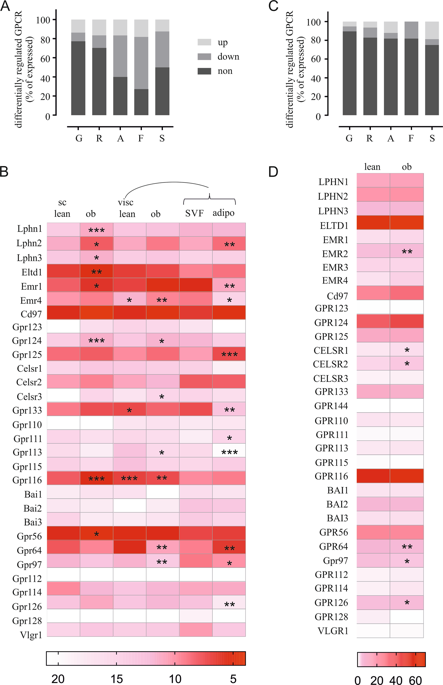当前位置:
X-MOL 学术
›
Int. J. Obesity
›
论文详情
Our official English website, www.x-mol.net, welcomes your feedback! (Note: you will need to create a separate account there.)
The repertoire of Adhesion G protein-coupled receptors in adipocytes and their functional relevance.
International Journal of Obesity ( IF 4.9 ) Pub Date : 2020-03-19 , DOI: 10.1038/s41366-020-0570-2 Tomáš Suchý 1 , Christian Zieschang 1 , Yulia Popkova 2 , Isabell Kaczmarek 1 , Juliane Weiner 3 , Aenne-Dorothea Liebing 1 , Mehmet Volkan Çakir 1 , Kathrin Landgraf 4 , Martin Gericke 5 , John Andrew Pospisilik 6 , Antje Körner 4 , John T Heiker 7, 8 , Dirk Dannenberger 9 , Jürgen Schiller 2 , Torsten Schöneberg 1 , Ines Liebscher 1 , Doreen Thor 1
International Journal of Obesity ( IF 4.9 ) Pub Date : 2020-03-19 , DOI: 10.1038/s41366-020-0570-2 Tomáš Suchý 1 , Christian Zieschang 1 , Yulia Popkova 2 , Isabell Kaczmarek 1 , Juliane Weiner 3 , Aenne-Dorothea Liebing 1 , Mehmet Volkan Çakir 1 , Kathrin Landgraf 4 , Martin Gericke 5 , John Andrew Pospisilik 6 , Antje Körner 4 , John T Heiker 7, 8 , Dirk Dannenberger 9 , Jürgen Schiller 2 , Torsten Schöneberg 1 , Ines Liebscher 1 , Doreen Thor 1
Affiliation

|
BACKGROUND
G protein-coupled receptors (GPCR) are well-characterized regulators of a plethora of physiological functions among them the modulation of adipogenesis and adipocyte function. The class of Adhesion GPCR (aGPCR) and their role in adipose tissue, however, is poorly studied. With respect to the demand for novel targets in obesity treatment, we present a comprehensive study on the expression and function of this enigmatic GPCR class during adipogenesis and in mature adipocytes.
METHODS
The expression of all aGPCR representatives was determined by reanalyzing RNA-Seq data and by performing qPCR in different mouse and human adipose tissues under low- and high-fat conditions. The impact of aGPCR expression on adipocyte differentiation and lipid accumulation was studied by siRNA-mediated knockdown of all expressed members of this receptor class. The biological characteristics and function of mature adipocytes lacking selected aGPCR were analyzed by mass spectrometry and biochemical methods (lipolysis, glucose uptake, adiponectin secretion).
RESULTS
More than ten aGPCR are significantly expressed in visceral and subcutaneous adipose tissues and several aGPCR are differentially regulated under high-caloric conditions in human and mouse. Receptor knockdown of six receptors resulted in an impaired adipogenesis indicating their expression is essential for proper adipogenesis. The altered lipid composition was studied in more detail for two representatives, ADGRG2/GPR64 and ADGRG6/GPR126. While GPR126 is mainly involved in adipocyte differentiation, GPR64 has an additional role in mature adipocytes by regulating metabolic processes.
CONCLUSIONS
Adhesion GPCR are significantly involved in qualitative and quantitative adipocyte lipid accumulation and can control lipolysis. Factors driving adipocyte formation and function are governed by signaling pathways induced by aGPCR yielding these receptors potential targets for treating obesity.
中文翻译:

脂肪细胞中粘附 G 蛋白偶联受体的库及其功能相关性。
背景 G 蛋白偶联受体 (GPCR) 是多种生理功能的充分表征的调节剂,其中包括脂肪生成和脂肪细胞功能的调节。然而,对粘附 GPCR (aGPCR) 的类别及其在脂肪组织中的作用的研究很少。关于肥胖治疗中对新靶点的需求,我们对脂肪生成过程中和成熟脂肪细胞中这种神秘 GPCR 类的表达和功能进行了全面的研究。方法 通过重新分析 RNA-Seq 数据并在低脂肪和高脂肪条件下在不同的小鼠和人类脂肪组织中进行 qPCR,确定所有 aGPCR 代表的表达。aGPCR 表达对脂肪细胞分化和脂质积累的影响通过 siRNA 介导的该受体类别所有表达成员的敲低来研究。通过质谱和生化方法(脂肪分解、葡萄糖摄取、脂联素分泌)分析缺乏选定 aGPCR 的成熟脂肪细胞的生物学特性和功能。结果在内脏和皮下脂肪组织中超过10个aGPCR显着表达,并且在人和小鼠的高热量条件下,几个aGPCR差异调节。六种受体的受体敲低导致脂肪生成受损,表明它们的表达对于适当的脂肪生成至关重要。更详细地研究了两个代表 ADGRG2/GPR64 和 ADGRG6/GPR126 的改变的脂质组成。虽然 GPR126 主要参与脂肪细胞分化,但 GPR64 通过调节代谢过程在成熟脂肪细胞中具有额外的作用。结论粘附GPCR显着参与定性和定量脂肪细胞脂质积累并且可以控制脂肪分解。驱动脂肪细胞形成和功能的因素受 aGPCR 诱导的信号通路控制,产生这些受体作为治疗肥胖症的潜在目标。
更新日期:2020-04-24
中文翻译:

脂肪细胞中粘附 G 蛋白偶联受体的库及其功能相关性。
背景 G 蛋白偶联受体 (GPCR) 是多种生理功能的充分表征的调节剂,其中包括脂肪生成和脂肪细胞功能的调节。然而,对粘附 GPCR (aGPCR) 的类别及其在脂肪组织中的作用的研究很少。关于肥胖治疗中对新靶点的需求,我们对脂肪生成过程中和成熟脂肪细胞中这种神秘 GPCR 类的表达和功能进行了全面的研究。方法 通过重新分析 RNA-Seq 数据并在低脂肪和高脂肪条件下在不同的小鼠和人类脂肪组织中进行 qPCR,确定所有 aGPCR 代表的表达。aGPCR 表达对脂肪细胞分化和脂质积累的影响通过 siRNA 介导的该受体类别所有表达成员的敲低来研究。通过质谱和生化方法(脂肪分解、葡萄糖摄取、脂联素分泌)分析缺乏选定 aGPCR 的成熟脂肪细胞的生物学特性和功能。结果在内脏和皮下脂肪组织中超过10个aGPCR显着表达,并且在人和小鼠的高热量条件下,几个aGPCR差异调节。六种受体的受体敲低导致脂肪生成受损,表明它们的表达对于适当的脂肪生成至关重要。更详细地研究了两个代表 ADGRG2/GPR64 和 ADGRG6/GPR126 的改变的脂质组成。虽然 GPR126 主要参与脂肪细胞分化,但 GPR64 通过调节代谢过程在成熟脂肪细胞中具有额外的作用。结论粘附GPCR显着参与定性和定量脂肪细胞脂质积累并且可以控制脂肪分解。驱动脂肪细胞形成和功能的因素受 aGPCR 诱导的信号通路控制,产生这些受体作为治疗肥胖症的潜在目标。


























 京公网安备 11010802027423号
京公网安备 11010802027423号